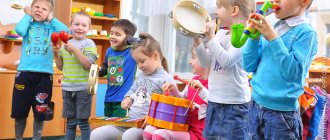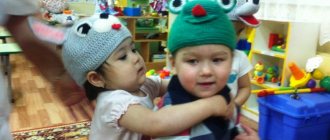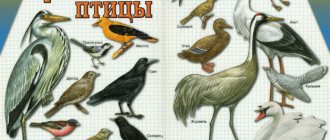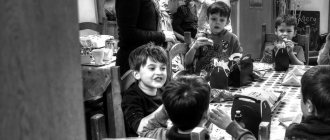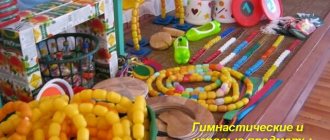Methodology for organizing outdoor games with children of different ages
The methodology for conducting outdoor play includes unlimited possibilities for the integrated use of various techniques aimed at shaping the child’s personality and its skillful pedagogical guidance. Of particular importance is the professional training of the teacher, pedagogical observation and foresight. By stimulating a child’s interest in play, engaging him in play activities, the teacher notices and highlights significant factors in the development and behavior of children. It is necessary to determine (sometimes in individual strokes) real changes in knowledge, skills and abilities. Pedagogical observation and love for children allow the teacher to thoughtfully choose methods for managing children’s activities, correct the child’s behavior and his own, and create a joyful, friendly atmosphere in the group. Children's joy that accompanies play is a powerful factor in the formation of the physical, mental, spiritual, aesthetic and moral principles of a child's development.
The selection and planning of outdoor games depend on the working conditions of each age group: the general level of physical and mental development of children, their motor skills, the health status of each child, his individual typological characteristics, the time of year, the characteristics of the regime, the location, the interests of the children. When selecting story-based games, the child’s well-developed ideas about the plot being played out are taken into account. To better understand the game plot, the teacher carries out preliminary work with the child: reads works of fiction, organizes observations of nature, the habits of animals, the activities of people of various professions (firemen, drivers, athletes, etc.), and conducts conversations.
The teacher pays significant attention to preparing the attributes of the game. The teacher makes them together with the children or in their presence (depending on age).
It is important to organize the game correctly depending on the content and order of tasks. It can be carried out simultaneously with all children or with a small group. The teacher varies the ways of organizing games depending on their structure and the nature of movements. He is thinking about ways to gather children to play and introduce game attributes. Children are introduced to a new game clearly, concisely, figuratively, and emotionally within 1.5-2 minutes. An explanation of the plot-based outdoor game, as already noted, is given after preliminary work with the child on the formation of ideas about game images. The themes of plot-based outdoor games are varied: these can be episodes from people’s lives, natural phenomena, or imitation of animal habits. During the explanation of the game, a game goal is set for children, which helps to activate thought, understand the rules of the game, and form and improve motor skills. When explaining the game, a short figurative storyline is used. It changes in order to better transform the child into a playful image, develop expressiveness, beauty, and graceful movements; fantasies and imagination of the baby. When explaining a non-story game, the teacher reveals the sequence of game actions, game rules and signal. He indicates the locations of the players and game attributes using spatial terminology (in younger groups with a focus on the object, in older groups without them).
When explaining the game, the teacher should not be distracted by comments to the children. Using questions, he checks how the children understand the game. If the rules of the Game are clear to them, then it is fun and exciting.
By uniting players into groups or teams, the teacher takes into account the physical development and individual characteristics of the children. The teacher selects children of equal strength for teams; To activate insecure, shy children, they are connected with brave and active ones.
The teacher's guidance of outdoor play consists of the distribution of roles in the games. The teacher can appoint a driver, choose using a counting rhyme, or invite the children to choose a driver themselves and ask them, then explain why they assign the role to this particular child; he can take the leading role or choose someone who wants to be the driver. In younger groups, the role of the leader is initially performed by the teacher himself. He does it emotionally, figuratively. Children are gradually given leading roles.
During the game, the teacher pays attention to the child’s compliance with the rules. He carefully analyzes the reasons for their violation. A child may break the rules of the game in the following cases: if he does not understand the teacher’s explanation accurately enough; I really wanted to win; was not attentive enough, etc.
The teacher must monitor the movements, relationships, load, and emotional state of the child in the game. He pays considerable attention to options for outdoor games, which allow not only to increase the child’s interest in the game, but also to complicate mental and physical tasks, improve movements, and improve the child’s psychophysical qualities.
Carrying out outdoor games in different age groups Game activity begins already in pre-preschool age . In order for children to play fully, it is necessary to create a pedagogically appropriate external environment for them and select the right toys. Second year children
life is very dynamic.
To satisfy their need for movement, it is necessary to have a slide, benches, boxes and other aids. Children should be provided with enough space to run, climb steps, slide down slides, etc., play hide and seek and catch up. In the games of children over one and a half years old,
one can notice signs of Imitation of adults. Taking this into account, the teacher involves children in games with the help of toys, trying to awaken their interest with an emotional figurative explanation. In younger groups, story games and the simplest non-story games such as “trap”, as well as fun games, are most often used.
Children are attracted to the game mainly by the action process: they are interested in running, catching up, throwing, etc. It is important to teach the child to act exactly on a signal and obey the simple rules of the game. The success of the game in the younger group depends on the teacher. It should interest children and give examples of movements.
For the younger group, games with text are recommended. When playing games such as “Hare”, “Train”, etc., the teacher expressively reads the text, illustrating it with appropriate movements. Such games develop a sense of rhythm in children. Children, listening to the teacher, try to imitate his movements.
By the middle group, children accumulate motor experience, movements become more coordinated. Taking this factor into account, the teacher complicates the conditions of the game: the distance for running, throwing, and jumping height increase; In this group, the teacher already distributes roles among the children. The role of the Leader is initially assigned to children who can handle it. If the child is unable to accurately complete the task, Non may lose faith in his abilities and it will be difficult to attract him to active actions. The teacher celebrates the children’s successes in the doctorate, fosters goodwill, forms honesty and justice. In the middle group, plot games such as “Cat and Mice”, “Kittens and Puppies”, “Mousetrap”, etc. are widely used, non-plot games - “Find yourself a mate”, “Whose link will get together sooner?” etc. As in the younger group, the teacher, when conducting a story game, uses a figurative story. Fairy-tale play images encourage the child to combine real features of the perceived plot into new combinations. The imagination of a child of the 5th year of life is of a recreative nature, so the teacher must guide its development all the time. In this regard, the role of a figurative plot story is great. For example, you can offer children the game “Kids and the Wolf.” This explanation of the plot does not take more than one and a half minutes. It does not reduce the motor activity of children or the motor density of the game. At the same time, children’s passion for play makes it possible to solve educational problems in a complex manner.
In outdoor games for children of senior preschool age, more complex movements are used. Children are given the task of instantly reacting to changes in the game situation, showing courage, intelligence, endurance, ingenuity, and dexterity.
The movements of children in the older group are characterized by greater coordination and accuracy, therefore, along with plot and non-story games, games with elements of competition are widely used, which at first it is advisable to introduce between several children who are equal in physical strength and development of motor skills. So, in the game “Who will reach the flag faster?” 2-3 children complete the task. As children master skills and navigate in space, competitions on links are introduced. The best team is considered to be the one whose members complete the task quickly and correctly.
In the pre-school group, most children have a good command of the basic movements. The teacher pays attention to the quality of movements, making sure that they are light, beautiful, and confident. Children must quickly navigate space, show restraint, courage, resourcefulness, and creatively solve motor problems. In games, it is necessary to set tasks for children to solve independently.
So, in the game “Colored Figures”, children are divided into links, and in each section a leader is chosen. At the teacher’s signal, children with flags in their hands scatter around the hall. At the command “Circle!” they find their leader and form a circle. Then the task becomes more complicated: the children also scatter around the hall and at the command “In a circle!” They are built around the leader, and while the teacher counts to 5, they lay out some figure from the flags.
In the school preparatory group, along with story-based and non-storyline games, relay races, sports games, and games with elements of competition are held. Children in the preparatory group should know all the ways to select leaders and widely use counting rhymes.
Children of all ages have a great need for play, and it is very important to use outdoor play not only to improve motor skills, but also to develop all aspects of the child’s personality. A well-thought-out methodology for conducting outdoor games helps to reveal the child’s individual abilities, helps to raise him healthy, cheerful, cheerful, active, able to independently and creatively solve a wide variety of problems.
